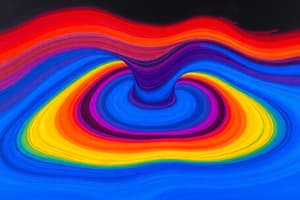Podcast
Questions and Answers
What is heat energy scientifically defined as?
What is heat energy scientifically defined as?
- Energy that is generated by burning substances
- Energy related to the movement of air particles
- Energy that makes you feel cold
- Energy transferred from a hot to a cooler object (correct)
What is the normal range of body temperature measured by a clinical thermometer?
What is the normal range of body temperature measured by a clinical thermometer?
- 32°C to 40°C
- 30°C to 35°C
- 36°C to 45°C
- 35°C to 42°C (correct)
What type of thermometer is specifically used to measure temperatures other than the human body?
What type of thermometer is specifically used to measure temperatures other than the human body?
- Maximum-minimum thermometer
- Laboratory thermometer (correct)
- Digital thermometer
- Clinical thermometer
Why are digital thermometers preferred over clinical thermometers containing mercury?
Why are digital thermometers preferred over clinical thermometers containing mercury?
What is the primary purpose of a maximum-minimum thermometer?
What is the primary purpose of a maximum-minimum thermometer?
What is the range of a typical laboratory thermometer mentioned?
What is the range of a typical laboratory thermometer mentioned?
Which material is classified as a conductor of heat?
Which material is classified as a conductor of heat?
What occurs during the process of convection?
What occurs during the process of convection?
What best describes the process of a sea breeze?
What best describes the process of a sea breeze?
Which statement about heat absorption is true?
Which statement about heat absorption is true?
Flashcards are hidden until you start studying
Study Notes
Heat Energy
- Heat energy is a form of energy that creates sensations of hot or cold.
- It involves the transfer of energy from hotter to cooler objects.
- Temperature measures the degree of hotness of an object.
Measuring Temperature
- Thermometers are devices used to measure temperature.
Clinical Thermometer
- Designed specifically for measuring human body temperature.
- Consists of a narrow glass tube with a mercury bulb.
- Utilizes the Celsius scale (°C), normal body temperature is 37°C.
- The measurement range is between 35°C and 42°C.
- Usage involves placing the bulb under the tongue for a minute.
- Digital thermometers are becoming popular due to safety concerns with mercury.
Maximum-Minimum Thermometers
- Measures the highest and lowest temperatures over a given time period.
- Features a U-shaped glass tube to record temperature fluctuations.
Laboratory Thermometer
- Used for measuring temperatures of substances other than the human body.
- Comprises a long glass tube without kinks and a mercury bulb.
- Temperature range is from -10°C to 110°C, used for boiling and freezing point checks.
Transfer of Heat
- Heat transfers from hotter objects to cooler objects.
Conduction
- Heat transfer occurs through direct contact from hot to cold parts of an object.
- Conductors (e.g. iron, copper) allow heat to pass, while insulators (e.g. wood, plastic) prevent heat transfer.
Convection
- Heat transfer in liquids and gases occurs through the movement of heated molecules.
- Example: In boiling water, hot molecules rise and are replaced by cooler ones.
- Sea breeze occurs when land heats faster than the sea, causing cool air from the sea to flow inland.
- Land breeze happens at night when land cools faster than sea, causing cool air from land to flow to the sea.
Radiation
- Heat is transferred without a medium (e.g. air, liquid).
- Example: Heat from the sun or a hot object cooling in the environment.
- All hot bodies are capable of radiating heat.
Absorption of Heat
- Objects can reflect or absorb radiant heat.
- Dark colors absorb heat effectively, making them comfortable in winter.
- Light colors reflect heat, leading to comfort in summer.
- Wool is a poor conductor, providing insulation in winter climates.
Studying That Suits You
Use AI to generate personalized quizzes and flashcards to suit your learning preferences.




